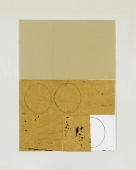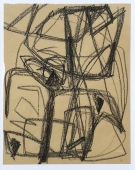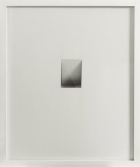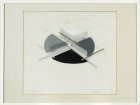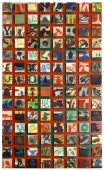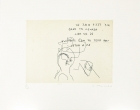
Artist | Bruce Nauman (*1941)
https://www.artist-info.com/artist/Bruce-Nauman
 Artist Portfolio Catalog
Artist Portfolio Catalog
| Image | Artist | Title | Year | Material | Measurement | ||||||||||||||||||||
|---|---|---|---|---|---|---|---|---|---|---|---|---|---|---|---|---|---|---|---|---|---|---|---|---|---|
 |
Bruce Nauman | Perfect Balance (Pink Andrew wit... | 1989 | wax casting (red dental-wax) b/w... | head 29x25x17 / monitor 21,8x22,4x25,2 / video 19,3x42,3x48,8 cm | ||||||||||||||||||||

Bruce Nauman (*1941)Perfect Balance (Pink Andrew with plug hanging with TV)
|
|||||||||||||||||||||||||
 |
Bruce Nauman | Normal Desires | 1973 | lithograph | 62,2 x 90,2 cm | ||||||||||||||||||||

Bruce Nauman (*1941)Normal Desires
|
|||||||||||||||||||||||||
 |
Bruce Nauman | Sugar / Ragus | 1973 | lithograph and silkscreen | 70,5 x 91,4 cm | ||||||||||||||||||||

Bruce Nauman (*1941)Sugar / Ragus
|
|||||||||||||||||||||||||
Biography
Biography
born in Indiana in 1941
About the work (english / deutsch)
About the work (english / deutsch)
Perfect Balance
The literal descriptiveness of the title he has given to the sculpture Perfect Balance (Pink Andrew with plug hanging with T.V.), 1989, is something of a pitfall: an aesthetic category of balance and harmony is used to refer to a blatantly violent context. This can only be grasped in terms of irony, as the head (Andrew) does not actually balance on the monitor. It balances virtually on the „Up yours“ finger, the hand to be seen in the electronic medium. On closer inspection of this endless tape, the apparent obscenity of the gesture no longer holds true. In a sense, it is directed inwards, indicating the artist’s studio - a private space. The finger is not a gesture aimed at us; we assume that it is Nauman’s hand. But this hand with its erect middle finger also becomes our own. Attacker and victim, oppressor and oppressed cannot be distinguished. Whereas in Nauman’s early tapes, his studio was largely empty, here we recognise parts of the artist’s sculptures and the foam shapes of larger animals, including a stag. The artist purchased these „models“ from a taxidermy supplies catalogue. Nauman’s hanging head sculptures, including „Perfect Balance“ and the other sculpture in this room, Hanging Heads (Blue Andrew, mouth open / Red Julie with cap), 1989, have the same model character. With its single head and the playback equipment of the monitor standing on the floor, Perfect Balance has a more potent sculptural plasticity than the „Hanging Heads“ he has arranged, for example, in a sweeping circle in other works. In this respect, Hanging Heads is also an installation which we can enter, as it were. Whether we actually choose to do so, given the unavoidable associations of torture and Ausschwitz, is quite another matter. In spite of the sensitive realism of these heads made of dental wax, there is something profoundly abstract about the material and object of these moulded forms, all of them produced in exactly the same way and yet all of them "portraits", for the most part bearing the first name of the model. Within the group, they are aligned in all kinds of constellations, inter-relationships, juxtapositions, super-impositions. And although we are accustomed to seeing the entire person in the presentation of a human head or face, „Perfect Balance“ makes it clear that, beyond the electronic machinery, there are only fragments: parts of animals, a forearm, a head without a torso.
In these two works, Hanging Heads and Perfect Balace, as in the group as a whole, inhumanity appears to be epitomised by a human figure „hung on a wire“. To gaze at the head dangling upside down in the air is to be drawn inexorably into a sense of complicity. Even if one hangs oneself, the head remains attached. The material Bruce Nauman uses to form the heads of Andrew and Julie plays a decisive role. He uses a specific wax that is harder and, in a way, colder than beeswax: the dental wax normally used by dental technicians. It is, infact, the almost indescribable coldness of this wax, the visible joints of the moulded parts of the head, the lack of finish and the apparent "defects" in production which, for all their portrait-like verisimilitude, call to mind the medical penetration of the human body. The history of medicine is only the most striking example of the Enlightenment, the other side of which is represented by the Dialectics of the Enlightenment. The reason of scientific action transmutes into unreason, the sensual wholeness of the body decays into noncorporeal abstraction. The body is dismembered into its minutest particles. When Bruce Nauman explains that one of the driving forces behind his work is his disappointment at the conditio humana, it is easy to see how closely his art is linked to the philosophy of Michel Foucault. Foucault used the example of medicine to illustrate the history of the Enlightenment - not as the progress of reason and humanity, but as the rise of supra-individual power contexts whose finest offshoots eventually permeate the body. From this point of view, it becomes virtually impossible to distinguish between interior and exterior, public and private. In a text dated 1987, the artist stressed: „People die of exposure“. Nauman uses video technology - especially in his installations - to heighten awareness of the role this technology plays as a medium of social control. The origins of this instrumental view are described by Foucault in his prison example in "Discipline and Punish," trans. A.M. Sheridan Smith (New York, 1975).
German text by Hubert Beck / Translation by Ishbel Flett
(Extract - Full printed version available in the Museum)
MMK - Museum für Moderne Kunst, Frankfurt am Main
Perfect Balance
Der Titel der Skulptur Perfect Balance (Pink Andrew with plug hanging with T.V.), 1989, ist deskriptiv wörtlich, stellt aber eine Art Falle dar. Der offensichtliche Gewaltzusammenhang erscheint unter dem Titel einer ästhetischen Kategorie, der des Gleichgewichts und der Ausgewogenheit. Dies läßt sich nur ironisch verstehen, denn real balanciert der Kopf (Andrew) nicht auf dem Monitor. Virtuell balanciert er auf dem Finger des „Up yours“, der Hand, die im elektronischen Medium zu sehen ist.
Schauen wir uns dieses Tape, das in einer Endlosschleife läuft, genauer an, zerfällt die vermeintliche Obszönität der Geste. Sie ist gewissermaßen nach innen, in das Atelier des Künstlers gerichtet, einen eigentlich privaten Raum. Der Finger gilt nicht uns, wir schließen, daß es Naumans Hand ist. Diese Hand mit dem aufgestellten Mittelfinger wird aber auch zu unserer. Täter und Opfer sind letztlich nicht auseinanderzuhalten. War in Naumans frühen Tapes sein Atelier meist leer, erkennen wir hier Teile der Tierleiber-Plastiken des Künstlers, und zwar die geschäumten Formen größerer Tiere, etwa eines Hirsches. Diese „Modelle“ hat der Künstler nach einem Katalog für Tierpräparatoren gekauft. Solchen Modellcharakter haben auch die hängenden Kopf-Plastiken Naumans, zu denen „Perfect Balance“ gehört, wie auch die zweite Skulptur in diesem Raum: Hanging Heads (Blue Andrew, mouth open / Red Julie with cap), 1989.
Durch den einzelnen Kopf und das zum Monitor gehörende Abspielgerät, das auf dem Boden steht, ist Perfect Balance stärker skulptural als die „Hanging Heads“, die in anderen Arbeiten der Werkgruppe z.B. ausladend kreisförmig arrangiert sind. Hanging Heads ist daher auch eine Installation, die wir quasi betreten können. Ob wir dies dann tun, ist angesichts der sich aufdrängenden Assoziationen von Folter und Ausschwitz eine andere Frage. Trotz der sensiblen Realitätsnähe dieser Köpfe aus Dentalwachs, dieser „Porträts“, bei denen ja meist der Vorname des Modells genannt ist, haben die immer auf gleiche Art hergestellten Abgüsse etwas zutiefst Abstraktes - Material- und Dingcharakter. So sind sie in der gesamten Werkgruppe wie Gegenstände auf alle mögliche Weise zueinander, neben- und übereinander angeordnet. Und obwohl wir gewohnt sind, bei der Darstellung des menschlichen Kopfes oder Gesichts den ganzen Menschen zu sehen, wird bei „Perfect Balance“ gerade deutlich, daß außer der elektronischen Maschine nur Fragmente dargestellt sind: Tierkörperteile, der Unterarm, der Kopf, zu dem der Leib fehlt. Wesentlich für die Plastik insgesamt ist auch die inszenierte Grenze, das Zusammenpressen zweier Register, dem Videobild und der Plastik, dort, wo die Schädeldecke auf dem Monitor aufliegt. Eine Berührung, die gerade einen Bruch hervorhebt. Naumans Verfahren könnte man als negative Anthropologie bezeichnen; an nichts erinnern mich diese Köpfe mehr, als an jene frühen Filmbilder des chinesischen Boxeraufstandes, in denen zu sehen ist, wie die Soldaten mit ihren Schwertern die Köpfe der knienden Opfer abschlagen. Je nach Präsentation der Köpfe, sieht man vor allem die grauenvollen Löcher, denn die Abgüsse sind innen hohl. Eine solche Problematisierung der Entgrenzung von innen und außen ist zentral im Werk Bruce Naumans. Seine Bodenstücke aus den siebziger Jahren, sind ja Skulpturen, die eigentlich nichts als Löcher sind. Die fehlende Leiblichkeit in Perfect Balance wird nicht zuletzt dadurch noch akzentuiert, daß die drei Teile der Skulptur (Abspielgerät, Monitor, Kopf) ein entferntes Echo der Dreiteiligkeit des menschlichen Körpers mit Beinen, Rumpf und Kopf darstellen.
Als Repräsentation der Inhumanität erscheint in den beiden Arbeiten Hanging Heads und Perfect Balace wie in der Werkgruppe insgesamt das an „Draht Aufgehängtsein“ der menschlichen Figur. Der Blick auf den Kopf, der falsch herum in der Luft hängt, kann kaum der Komplizenschaft entgehen. Selbst bei dem, der sich selbst aufhängt, bleibt der Kopf ein Haupt. Das Material, aus dem Bruce Nauman die Köpfe von Andrew und Julie abformt, spielt eine entscheidende Rolle. Er verwendet ein ganz spezifisches Wachs, das härter und sozusagen kälter ist als Bienenwachs, nämlich das in der Zahntechnik gebräuchliche Dental-Wachs. Gerade die schwer zu beschreibende Kälte dieses Wachses und die Spuren des Zusammensetzens der Abgußteile der Köpfe, das fehlende Finish und die vermeintlichen „Fehler“ bei der Herstellung lassen bei allem porträthaften Verismus an die Zurichtung des menschlichen Körpers in der Medizin denken. Und die Geschichte der Medizin ist nur das prägnanteste Beispiel der Aufklärung, deren andere Seite die Dialektik der Aufklärung darstellt. Die Vernunft wissenschaftlichen Handelns schlägt um in Unvernunft, die sinnliche Ganzheit des Körpers zerfällt in eine leibferne Abstraktheit. Der Körper wird bis in die letzten Partikel zerlegt. Wenn Bruce Nauman darüber hinaus sagt, ein Beweggrund für seine Arbeiten liegt in der Enttäuschung über die conditio humana, dann ist leicht einzusehen, wie nahe diese Werke dem Denken Michel Foucaults stehen. Dieser analysiert nicht zuletzt am Beispiel der Medizin die Geschichte der Aufklärung nicht als Fortschreiten von Rationalität und Humanität, sondern als Entstehen von überindividuellen Machtverhältnissen, deren feinste Verästelungen schließlich durch die Körper hindurchgehen. Auch so gesehen sind innen und außen, öffentlich und privat kaum mehr auseinanderzuhalten. In einem Text aus dem Jahr 1987 hat der Künstler betont: „People die of exposure“. Videotechnik bei Nauman - vor allem in den Installationen - ist immer so eingesetzt, daß die soziale Rolle dieser Technik als Überwachungsmedium deutlich wird. Den Ursprung dieses instrumentellen Blicks hat Foucault am Beispiel des Gefängnisses in „Überwachen und Strafen“ (Ffm, 1976) beschrieben.
Text von Hubert Beck
(Auszug - Der vollständige Text ist als Informationsblatt beim Museum erhältlich)
MMK - Museum für Moderne Kunst, Frankfurt am Main
 Exhibition Announcements Exhibition Announcements 
| Learn more about this service |
|---|
 offers / Requests offers / Requests  |
Learn more about this service |
|---|
 Visualization |
Learn more about this service | ||
|---|---|---|---|

Interested in discovering more of this artist's networks?
3 easy steps: Register, buy a package for a visualization, select the artist.
See examples how visualization looks like for an artist, a curator, or an exhibition place: Gallery, museum, non-profit place, or collector.

Exhibition History

|
SUMMARY based on artist-info records. More details and Visualizing Art Networks on demand. Venue types: Gallery / Museum / Non-Profit / Collector |
||||||||||||
| Exhibitions in artist-info | 616 (S 132/ G 484) |
Did show together with - Top 5 of 5910 artists (no. of shows) - all shows - Top 100
|
||||||||||
| Exhibitions by type | 616: 201 / 246 / 161 / 8 | |||||||||||
| Venues by type | 321: 96 / 111 / 108 / 6 | |||||||||||
| Curators | 277 | |||||||||||
| artist-info records | May 1966 - Jan 2025 | |||||||||||
|
Countries - Top 5 of 26 United States (214) Germany (172) Switzerland (34) Belgium (28) France (21) |
Cities - Top 5 of 130 New York (149) Los Angeles (28) Frankfurt am Main (22) Berlin (22) Düsseldorf (19) |
Venues (no. of shows )
Top 5 of 321
|
||||||||||
Curators (no. of shows)
Top 5 of 277
|
| Sperone Westwater | S | Oct 2024 - Jan 2025 | New York | (81) | +0 | |
| Whitechapel Gallery | G | Feb 2022 - Jun 2022 | London | (417) | +0 | |
| Blazwick, Iwona (Curator) | +0 | |||||
| Kunst Museum Winterthur | G | Sep 2020 - Nov 2020 | Winterthur | (166) | +1 | |
| Bitterli, Konrad (Curator) | +0 | |||||
| Kost, Lynn (Curator) | +0 | |||||
| Saarland Museum, Moderne Galerie | G | Sep 2019 - Jan 2020 | Saarbrücken | (76) | +0 | |
| LWL-Museum für Kunst und Kultur | G | Nov 2018 - Mar 2019 | Münster | (171) | +0 | |
| Pirsig-Marshall, Tanja (Curator) | +0 | |||||
| Bartels, Kristin (Curator) | +0 | |||||
| PalaisPopulaire | G | Sep 2018 - Jan 2019 | Berlin | (2) | +0 | |
| Hütte, Friedhelm (Curator) | +0 | |||||













